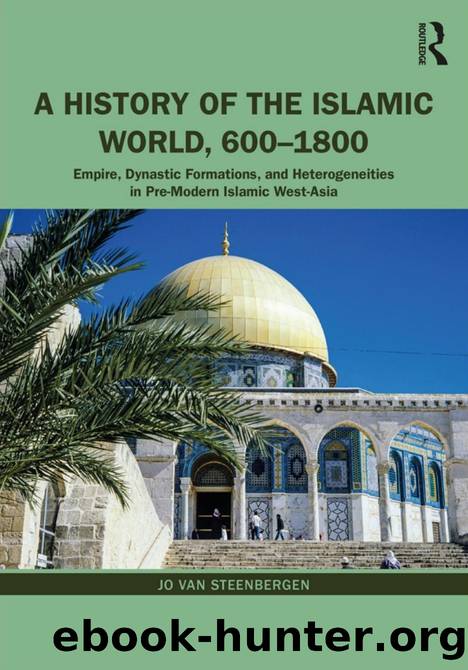A History of the Islamic World, 600-1800: Empire, Dynastic Formations, and Heterogeneities in Pre-Modern Islamic West-Asia by Jo van Steenbergen

Author:Jo van Steenbergen [Steenbergen, Jo van]
Language: eng
Format: epub
Tags: History, General, Asia, India & South Asia, Middle East, World, Europe, Medieval, Modern, 17th Century, 18th Century, 16th Century, Civilization, Southeast Asia, Central Asia, Religion, Islam, Social Science, Islamic Studies
ISBN: 9781000093070
Google: cWLyDwAAQBAJ
Amazon: 0415660327
Publisher: Routledge
Published: 2020-08-11T05:00:00+00:00
1.2 Latin lordships between West-Asian integration and confrontation
Around 1100, after this and a few more victories (especially at Ascalon, on 12 August 1099, against a Fatimid relief force from Egypt), about 300 Latin knights and their entourages are reported to have remained in the coastal lands of southwestern Syria to consolidate their hold of Jerusalem and its hinterland. Ultimately, four new Latin-Christian feudal lordships emerged in the regions between southeastern Anatolia and the Egyptian Sinai, often rather anachronistically referred to in modern scholarship as âthe crusader statesâ. These were led by the Latin Kingdom of Jerusalem (1099â1187 /1291), briefly ruled by the aforementioned Godfrey of Bouillon (d. 1100) and then by his brother Baldwin of Boulogne (d. 1118). The other lordships were the Principality of Antioch (1098â1268), the County of Tripoli (1102â1289), and the County of Edessa (1098â1144). Their âFrankishâ elites, mostly composed of Latin nobles and citizens, ruled various local populations who were active in trade and agriculture and consisted of eastern Christians and Jews as well as Muslims.
These Latin lordships soon became integral participants in the highly complex, unstable, and competitive Syro-Iraqi landscape of Seljuk and post-Seljuk leaderships. For many decades, they actually continued to appear as active local and regional partners as well as occasional opponents and rivals for trans-regional pre-eminence amid the complex webs of Syro-Iraqi relationships of power.8 The latter was especially the case in the reigns of the kings Baldwin III (r. 1143â1162) and his brother Amalric of Jerusalem (r. 1162â1174), both born in the kingdom during the reign of their parents, king Fulc (r. 1131â1143) and queen Melisende (r. 1131â1161), herself the product of the mixed marriage of king Baldwin II (r. 1118â1131) with a local Greek-Armenian princess.
Download
This site does not store any files on its server. We only index and link to content provided by other sites. Please contact the content providers to delete copyright contents if any and email us, we'll remove relevant links or contents immediately.
The History of Jihad: From Muhammad to ISIS by Spencer Robert(2575)
Nine Parts of Desire by Geraldine Brooks(2328)
The Turkish Psychedelic Explosion by Daniel Spicer(2314)
The First Muslim The Story of Muhammad by Lesley Hazleton(2222)
The Essential Rumi by Coleman Barks(1992)
1453 by Roger Crowley(1971)
The Last Mughal by William Dalrymple(1834)
Trickster Travels: A Sixteenth-Century Muslim Between Worlds by Davis Natalie Zemon(1815)
God by Aslan Reza(1616)
Muhammad: His Life Based on the Earliest Sources by Martin Lings(1608)
by Christianity & Islam(1596)
A Concise History of Sunnis and Shi'is by John McHugo(1547)
Magic and Divination in Early Islam by Emilie Savage-Smith;(1501)
No God But God by Reza Aslan(1498)
The Flight of the Intellectuals by Berman Paul(1466)
Art of Betrayal by Gordon Corera(1403)
Nothing to Envy by Barbara Demick(1389)
What the Qur'an Meant by Garry Wills(1363)
Getting Jesus Right: How Muslims Get Jesus and Islam Wrong by James A Beverley & Craig A Evans(1312)
